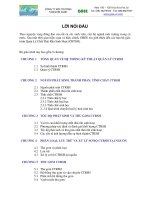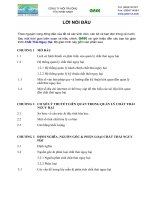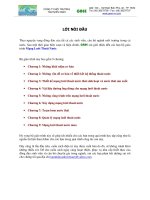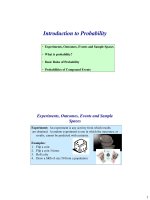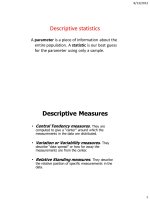Tài liệu tiếng anh - LAMNGHIEPVN.INFO (Hưng Bùi) UNIT 3
Bạn đang xem bản rút gọn của tài liệu. Xem và tải ngay bản đầy đủ của tài liệu tại đây (109.16 KB, 5 trang )
UNIT 3: MECHANISMS
A. Reading:
Scanning a text
Scanning is the best strategy for searching for specific information in a text. Move
your eyes up and down the text until you find the word or words you want. Try to ignore
any information which will not help you with your task.
1. Scan the text opposite quickly to find out which of these mechanisms are
mentioned
1. cam
2. tap3. pendulum
4. foot pump
5. Escalator
Mechanisms are an important part of everyday life. They allow us to do simple
things like switch on lights, turn taps, and open doors. They also make it possible to use
escalators and lifts, travel in cars and fly from continent to continent.
Mechanisms play a vital role in industry. While many industrial processes have
electronic control systems, it is still mechanisms that deliver the power to do the work.
They provide the forces to press steel sheets into car body panels, to lift large components
from place to place, to force plastic through dies to make pipes.
All mechanisms involve some kind of motion. The four basic kinds of motion are:
Rotary: Wheels, gears, and rollers involve rotary movement.
Oscillating: The pendulum of a clock oscillates – it swings backwards and
forwards.
Linear: The linear movement of a paper trimmer is used to cut the edge of the
paper.
Reciprocating: The piston in a combustion engine reciprocates.
Many mechanisms involve changing one kind of motion into another type. For
example, the reciprocating motion of a piston is changed into a rotary motion by the
crankshaft, while a cam converts the rotary motion of the engine into the reciprocating
motion to operate the valves.
2. Now read the text to find the answer to these questions.
1. What does a cam do ?
2. What does oscillating mean ?
3. How are plastic pipes formed ?
4. What simple mechanisms in the home are mentioned directly or indirectly?
5. What is the function of the crankshaft ?
6. Give an example of a device which can produce a linear movement ?
7. How are car body panels formed ?
8. What do mechanisms provide in industry ?
B. Language study:
1. Ways of linking ideas
When we write, we may have to describe, explain, argue, persuade, complain, etc. in all
these forms of writing, we use ideas. To make our writing effective, we have to make
sure our readers can follow our ideas. One way of helping our readers is to make the links
between the ideas in our writing.
What are the links between these pairs of ideas ? What words can we use to mark the
links ?
1. Mechanisms are important to us.
2. They allow us to travel.
3. Mechanisms deliver the power to do work.
4. They play a vital role in industry.
5. Friction is sometimes a help.
6. It is often a hindrance.
Sentence 2 is a reason for sentence 1. We can link 1 and 2 like this:
Mechanisms are important to us because/since/as they allow us to travel.
Sentence 4 is a result of sentence 3. We can link 3 and 4 like this:
Mechanisms deliver the power to do work so they play a vital role in industry.
Mechanisms deliver the power to do work; therefore they play a vital role in
industry.
Sentence 6 contrasts with sentence 5. We can link 5 and 6 like this:
Friction is sometimes a help but it is often a hindrance.
•
Show the links between these sets of ideas using appropriate linking words.
1. Copper is highly conductive. It is used for electric wiring.
2. Weight is measured in newtons. Mass is measured in kilogram.
3. Nylon is used for bearings. It is self-lubricating.
4. ABS has high impact strength. It is used for safety helmets.
5. The foot pump is the class 2 lever. The load is between the effort and the fulcrum.
6. Friction is essential in brakes. Friction is a nuisance in an engine.
7. The upper surface of a beam is in compression. The lower surface is in tension.
8. Concrete beams have steel rods near the lower surface. Concrete is weak in
tension.
2. Dealing with technical terms
One of the difficult things about the English of engineering is that there are many
technical terms to learn. Newer terms may be the same, or almost the same, in your own
language. But many terms will be quite different and you may not always remember
them. When this happens, you will have to use whatever English you know to make your
meaning clear.
•
The technical terms in column A are similar in meaning to the more general English
in column B. Match them.
1.
2.
3.
4.
5.
6.
7.
8.
A
oscillates
rotates
reciprocates
has a linear motion
converts
motion
escalator
sheets
C. Word study:
a.
b.
c.
d.
e.
f.
g.
h.
B
changes
large, thin, flat pieces
moving stairs
goes round and round
movement
goes in a line
swings backwards and forwards
goes up and down
Noun and Noun compounds
We can use adjectives to describe an object in greater detail. For example:
light
electric light
a motor
an electric motor
steel
stainless steel
gears
helical gear
We can also use nouns. For example:
light
laser light
a motor
an air motor
steel
carbon steel
gears
titanium gears
Many relationships are possible in noun compounds. For example:
an air motor
a motor which uses air
carbon steel
steel which contains carbon
titanium gears gears made of titanium
1. Put each of these examples in the correct column.
1. carbon blocks
2. a power tool
3. aluminium alloy
4. a ball bearing
5. carbon fibre
6. a concrete beam
7. a gas burner
8. a diesel boat
9. roller bearings
10. a spring balance
11. a circuit board
12. a plastic tube
13. a plastic pipe
14. steel sheets
15. magnesium alloy
Uses
……………
…………...
…………...
is made of
……………….
………………
………………
contains
………………..
………………..
………………..
…………...
…………...
…………...
…………...
…………...
………………
………………
………………
………………
………………
………………..
………………..
………………..
………………..
………………..
2. What new relationships can you find in the example below? Rewrite each compound to
show the relationship. For example:
a foot pump
a pump which is operated by foot
a ribbon cable a cable which is like a ribbon
a gear lever
1. chain wheel
2. disc wheel
3. foot brake
4. a hand throttle
5. strain gauge
a lever for operating gears
6. College lecturer
7. Toe-clip
8. Boiler thermostat
9. Safety helmet
10. Aircraft engineer
New words and expressions:
-
pendulum (n.):
con lắc
escalator (n.):
cầu thang cuốn
tap (n.):
vòi nước
cam (camshaft) (n.):
trục cam
make it possible:
làm cho có thể
continent (n.):
châu lục
play a vital role:
đóng/giữ một vai trò quan trọng
industrial processes:
qui trình công nghiệp
electronic control system:
hệ thống điều khiển bằng điện tử
oscillating (n.):
(chuyển động) dao động
linear (n.):
(chuyển động) thẳng
reciprocating:
(chuyển động) tới lui
rotary motion:
chuyển động quay
steel sheet:
tấm thép
fulcrum (n.):
điểm tựa
concrete beam:
dầm làm bằng bê-tông
stainless steel:
thép không gỉ
a spring balance:
cân lò xo
swing
backwards
and đung đưa lui tới
forwards:
trở lực
hindrance (n.):
tự bôi trơn
self-lubricating:
--- o0o ---
